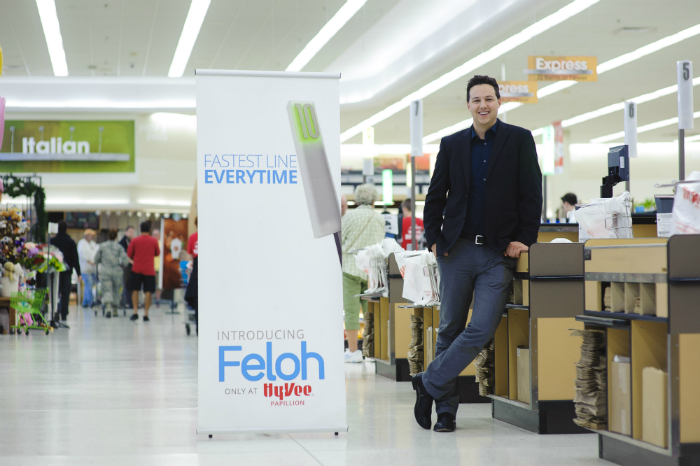
A few years ago Jacob Richards and his mother were checking out at HyVee in Sioux Center, Iowa.
“She said to me, ‘I wish I knew which line was shortest,’” said Richards.
As an engineering student at Dordt College, Richards started working on the problem like an engineer.
“I looked at thermal imaging. I looked into ultrasonic sensors on the floor,” said Richards. “It finally came down to, ‘We really need vision technology.’”
Out of that original problem, Richards developed Feloh, a computer vision platform that helps customers quickly find the fastest line and checkout faster.
How Feloh works
The patent pending Feloh system uses a tiny camera installed above each checkout lane to calculate which line has the shortest wait time.
Inside each checkout lane light are 833 LED bulbs that gradually change colors as the lines change. Green lights direct customers to the fastest line, while orange and red lights warn customers to avoid a slower one.
It’s so intuitive, many customers may not even be aware they are selecting the fastest lane. They just know they get out of the store faster.
For managers, Feloh provides a tablet-based dashboard with live streams of every checkout line, including metrics on current weight time and peak hours. The platform can also recommend times of the week that are understaffed and how many carts and baskets are being used on a given day of the week.
The lights also blink for a supervisor request, like typical cashier lights. But Feloh’s lights are much smarter, blinking at different intervals so managers can intuitively know at a glance which requests are highest priority.

Side benefit: Loss prevention
While testing Feloh in the store, Richards discovered that his computer vision platform could also recognize when items were left under the cart during checkout.
Customers walking out of the store with unpaid product in their cart is a major headache for retail store managers, costing them tens of thousands of dollars a year.
In the latest update, Feloh includes an alert to cashiers, letting them know that something is under the basket. What’s more, the system will take a picture of all under basket items with the time and date.
Investment and expanding locations
Richards, who graduated from Dordt College two years ago with an engineering degree, designed the physical components of Feloh himself and fabricated them in house–literally in his garage.
The Feloh platform has been in live beta at a HyVee in Papillion since May. According to Richards, the platform has been working flawlessly.
“We really took the lean method and just said, ‘Let’s go. Let’s get this product on the floor now,’” said Richards.
Richards has an agreement with HyVee to expand the platform as a paid trial to four more locations in Nebraska and Iowa in the coming year.
“Now that we have four more stores we actually have a production facility where will be making the 60-plus indicators we need to make,” said Richards.
The company has also received private investment from an Omaha technology consultant and is expanding its full-time team. They were also a recipient of the Nebraska prototyping grant this year.
The plan is to continue developing the platform and to bring on more stores as fast as possible.
“Our goal right now is 5 stores early next year, 50 stores by end of next year, and 150 the year after that,” said Richards.
—
Ryan Pendell is the Managing Editor of Silicon Prairie News.





One response to “Feloh’s computer vision helps shoppers find the fastest line”
or you could have just 1 line, which is optimal. but yeah… LEDs are neat